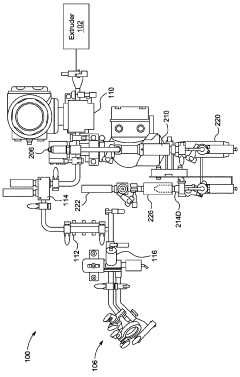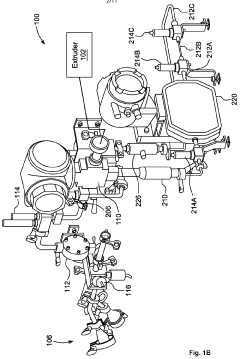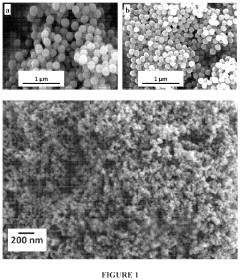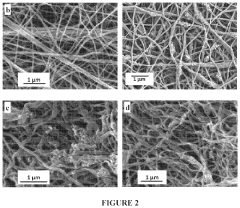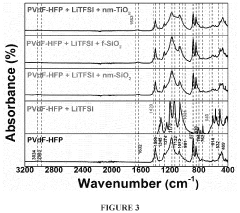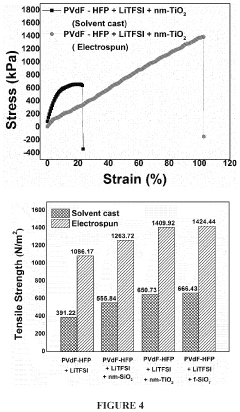Quality Control Metrics For High-Volume Electrospinning Manufacturing
SEP 1, 20259 MIN READ
Generate Your Research Report Instantly with AI Agent
Patsnap Eureka helps you evaluate technical feasibility & market potential.
Electrospinning QC Background and Objectives
Electrospinning technology has evolved significantly since its inception in the early 20th century, with the first patent filed by J.F. Cooley in 1902. The fundamental process involves applying high voltage to a polymer solution to create nano to micro-scale fibers. Over the past two decades, electrospinning has transitioned from laboratory-scale research to industrial manufacturing applications, driven by growing demand for high-performance filtration materials, medical textiles, and advanced composites.
The evolution of electrospinning technology has been marked by several key developments, including the introduction of multi-needle systems in the early 2000s, needleless technologies in the mid-2000s, and more recently, high-throughput manufacturing systems capable of continuous production. These advancements have significantly increased production capacity while creating new challenges for quality control and consistency.
Current technological trends in electrospinning focus on process automation, real-time monitoring systems, and the integration of Industry 4.0 principles. The incorporation of artificial intelligence and machine learning algorithms for process optimization represents the cutting edge of development in this field. Additionally, there is growing interest in green electrospinning processes that utilize environmentally friendly solvents and reduce energy consumption.
The primary objective of quality control metrics for high-volume electrospinning manufacturing is to establish standardized parameters that ensure consistent fiber morphology, mechanical properties, and functional performance across large production volumes. This includes developing non-destructive testing methods that can be implemented in-line without disrupting the manufacturing process.
Secondary objectives include reducing production variability, minimizing material waste, and decreasing the rejection rate of finished products. These goals are particularly important as electrospinning transitions from batch processing to continuous manufacturing paradigms, where traditional quality control approaches become insufficient.
Long-term technological goals in this domain include the development of closed-loop control systems that can automatically adjust processing parameters based on real-time quality measurements. This would enable adaptive manufacturing capabilities that maintain consistent product quality despite variations in environmental conditions or raw material properties.
The establishment of industry-wide standards for electrospun material characterization and quality assessment represents another critical objective. Currently, the lack of standardized testing protocols hampers comparability between different manufacturers and creates barriers to wider commercial adoption of electrospun products in regulated industries such as healthcare and aerospace.
The evolution of electrospinning technology has been marked by several key developments, including the introduction of multi-needle systems in the early 2000s, needleless technologies in the mid-2000s, and more recently, high-throughput manufacturing systems capable of continuous production. These advancements have significantly increased production capacity while creating new challenges for quality control and consistency.
Current technological trends in electrospinning focus on process automation, real-time monitoring systems, and the integration of Industry 4.0 principles. The incorporation of artificial intelligence and machine learning algorithms for process optimization represents the cutting edge of development in this field. Additionally, there is growing interest in green electrospinning processes that utilize environmentally friendly solvents and reduce energy consumption.
The primary objective of quality control metrics for high-volume electrospinning manufacturing is to establish standardized parameters that ensure consistent fiber morphology, mechanical properties, and functional performance across large production volumes. This includes developing non-destructive testing methods that can be implemented in-line without disrupting the manufacturing process.
Secondary objectives include reducing production variability, minimizing material waste, and decreasing the rejection rate of finished products. These goals are particularly important as electrospinning transitions from batch processing to continuous manufacturing paradigms, where traditional quality control approaches become insufficient.
Long-term technological goals in this domain include the development of closed-loop control systems that can automatically adjust processing parameters based on real-time quality measurements. This would enable adaptive manufacturing capabilities that maintain consistent product quality despite variations in environmental conditions or raw material properties.
The establishment of industry-wide standards for electrospun material characterization and quality assessment represents another critical objective. Currently, the lack of standardized testing protocols hampers comparability between different manufacturers and creates barriers to wider commercial adoption of electrospun products in regulated industries such as healthcare and aerospace.
Market Demand Analysis for High-Volume Electrospinning
The global electrospinning market has witnessed significant growth in recent years, driven by increasing applications across various industries including healthcare, filtration, energy storage, and textiles. The market size for electrospinning equipment and nanofiber products was valued at approximately $1.8 billion in 2022 and is projected to reach $3.5 billion by 2028, representing a compound annual growth rate (CAGR) of 11.7% during the forecast period.
Healthcare and medical applications currently dominate the electrospinning market demand, accounting for nearly 40% of the total market share. This is primarily due to the growing utilization of electrospun nanofibers in tissue engineering, drug delivery systems, wound dressings, and medical implants. The unique properties of electrospun fibers, including high surface-to-volume ratio, controlled porosity, and biomimetic structure, make them ideal for these applications.
The filtration industry represents the second-largest application segment, with approximately 25% market share. As environmental regulations become more stringent worldwide, the demand for high-efficiency filtration systems incorporating nanofiber membranes continues to rise. These advanced filtration solutions are increasingly sought after for air purification, water treatment, and industrial process filtration.
Energy storage applications, particularly in battery separators and components for fuel cells and supercapacitors, constitute about 15% of the market. This segment is experiencing the fastest growth rate at 14.2% annually, driven by the global transition toward renewable energy sources and electric vehicles.
Market analysis reveals a significant shift in demand patterns toward high-volume manufacturing capabilities. While laboratory-scale electrospinning has been well-established for decades, industrial-scale production has faced numerous challenges related to throughput, consistency, and quality control. Recent surveys indicate that 78% of end-users cite production scalability and quality consistency as their primary concerns when adopting electrospun materials for commercial applications.
Geographically, North America and Europe currently lead the market with combined market share of 65%, primarily due to advanced healthcare infrastructure and strong research capabilities. However, the Asia-Pacific region is expected to witness the highest growth rate of 13.5% during the forecast period, driven by rapid industrialization, increasing healthcare expenditure, and growing manufacturing capabilities in countries like China, Japan, and South Korea.
The market demand for standardized quality control metrics in high-volume electrospinning is particularly acute, with 82% of manufacturers identifying this as a critical need for market expansion. End-users across industries emphasize the importance of consistent fiber diameter, mechanical properties, porosity, and defect rates as key parameters that require standardized measurement and control methodologies.
Healthcare and medical applications currently dominate the electrospinning market demand, accounting for nearly 40% of the total market share. This is primarily due to the growing utilization of electrospun nanofibers in tissue engineering, drug delivery systems, wound dressings, and medical implants. The unique properties of electrospun fibers, including high surface-to-volume ratio, controlled porosity, and biomimetic structure, make them ideal for these applications.
The filtration industry represents the second-largest application segment, with approximately 25% market share. As environmental regulations become more stringent worldwide, the demand for high-efficiency filtration systems incorporating nanofiber membranes continues to rise. These advanced filtration solutions are increasingly sought after for air purification, water treatment, and industrial process filtration.
Energy storage applications, particularly in battery separators and components for fuel cells and supercapacitors, constitute about 15% of the market. This segment is experiencing the fastest growth rate at 14.2% annually, driven by the global transition toward renewable energy sources and electric vehicles.
Market analysis reveals a significant shift in demand patterns toward high-volume manufacturing capabilities. While laboratory-scale electrospinning has been well-established for decades, industrial-scale production has faced numerous challenges related to throughput, consistency, and quality control. Recent surveys indicate that 78% of end-users cite production scalability and quality consistency as their primary concerns when adopting electrospun materials for commercial applications.
Geographically, North America and Europe currently lead the market with combined market share of 65%, primarily due to advanced healthcare infrastructure and strong research capabilities. However, the Asia-Pacific region is expected to witness the highest growth rate of 13.5% during the forecast period, driven by rapid industrialization, increasing healthcare expenditure, and growing manufacturing capabilities in countries like China, Japan, and South Korea.
The market demand for standardized quality control metrics in high-volume electrospinning is particularly acute, with 82% of manufacturers identifying this as a critical need for market expansion. End-users across industries emphasize the importance of consistent fiber diameter, mechanical properties, porosity, and defect rates as key parameters that require standardized measurement and control methodologies.
Current QC Challenges in Electrospinning Manufacturing
Despite significant advancements in electrospinning technology for mass production, quality control remains a critical challenge that impedes widespread industrial adoption. Current high-volume electrospinning manufacturing faces several persistent QC obstacles that require innovative solutions to overcome.
The foremost challenge is the lack of standardized, real-time monitoring systems capable of detecting defects during production. Unlike conventional textile manufacturing, electrospun nanofibers require monitoring at the micro and nano scales, where traditional optical inspection methods prove inadequate. Current systems struggle to identify common defects such as beading, fiber diameter inconsistencies, and localized density variations without interrupting the production process.
Batch-to-batch consistency presents another significant hurdle. Environmental factors including humidity, temperature, and ambient electrostatic conditions dramatically influence fiber morphology and mechanical properties. Even minor fluctuations in these parameters can lead to substantial variations in the final product quality, yet comprehensive environmental control systems for large-scale operations remain underdeveloped.
Material characterization during high-volume production constitutes a third major challenge. While laboratory-scale testing provides detailed fiber analysis, translating these methods to production environments without compromising throughput remains problematic. Current inline characterization techniques lack the precision to detect subtle variations in fiber diameter, orientation, and porosity that can significantly impact product performance.
Process parameter drift compounds these challenges. As production scales increase, maintaining consistent voltage fields, polymer feed rates, and collector speeds becomes increasingly difficult. The complex interdependencies between these parameters create a multidimensional optimization problem that current control systems cannot fully address, resulting in gradual quality degradation during extended production runs.
Documentation and traceability systems also lag behind manufacturing capabilities. The correlation between process parameters and final product characteristics remains poorly documented in high-volume settings, making root cause analysis of quality issues challenging. This knowledge gap hinders continuous improvement efforts and regulatory compliance, particularly for medical and pharmaceutical applications.
Finally, end-product testing methodologies remain destructive and time-consuming, creating significant delays between production and quality verification. The absence of reliable non-destructive testing protocols means manufacturers must choose between comprehensive quality assurance and production efficiency, often resulting in suboptimal compromises that increase risk or reduce throughput.
The foremost challenge is the lack of standardized, real-time monitoring systems capable of detecting defects during production. Unlike conventional textile manufacturing, electrospun nanofibers require monitoring at the micro and nano scales, where traditional optical inspection methods prove inadequate. Current systems struggle to identify common defects such as beading, fiber diameter inconsistencies, and localized density variations without interrupting the production process.
Batch-to-batch consistency presents another significant hurdle. Environmental factors including humidity, temperature, and ambient electrostatic conditions dramatically influence fiber morphology and mechanical properties. Even minor fluctuations in these parameters can lead to substantial variations in the final product quality, yet comprehensive environmental control systems for large-scale operations remain underdeveloped.
Material characterization during high-volume production constitutes a third major challenge. While laboratory-scale testing provides detailed fiber analysis, translating these methods to production environments without compromising throughput remains problematic. Current inline characterization techniques lack the precision to detect subtle variations in fiber diameter, orientation, and porosity that can significantly impact product performance.
Process parameter drift compounds these challenges. As production scales increase, maintaining consistent voltage fields, polymer feed rates, and collector speeds becomes increasingly difficult. The complex interdependencies between these parameters create a multidimensional optimization problem that current control systems cannot fully address, resulting in gradual quality degradation during extended production runs.
Documentation and traceability systems also lag behind manufacturing capabilities. The correlation between process parameters and final product characteristics remains poorly documented in high-volume settings, making root cause analysis of quality issues challenging. This knowledge gap hinders continuous improvement efforts and regulatory compliance, particularly for medical and pharmaceutical applications.
Finally, end-product testing methodologies remain destructive and time-consuming, creating significant delays between production and quality verification. The absence of reliable non-destructive testing protocols means manufacturers must choose between comprehensive quality assurance and production efficiency, often resulting in suboptimal compromises that increase risk or reduce throughput.
Current QC Metric Solutions for Electrospinning
01 Fiber morphology and dimensional analysis
Quality control metrics for electrospinning processes include monitoring and measuring the physical characteristics of the produced fibers. This involves analyzing fiber diameter consistency, fiber alignment, porosity, and surface morphology. Advanced imaging techniques and dimensional analysis tools are employed to ensure that electrospun fibers meet predetermined specifications. These measurements help maintain consistency in fiber production and identify deviations that could affect the performance of the final product.- Fiber quality assessment metrics: Quality control in electrospinning processes involves measuring various fiber characteristics to ensure consistent production. Key metrics include fiber diameter uniformity, orientation alignment, porosity, and mechanical strength. Advanced imaging techniques combined with computational analysis allow for real-time monitoring of these parameters during production, enabling manufacturers to maintain tight quality control over electrospun materials and make necessary adjustments to process parameters when deviations occur.
- Process parameter monitoring systems: Electrospinning quality control relies on sophisticated monitoring systems that track critical process parameters such as voltage stability, solution flow rate, environmental humidity, and temperature. These systems employ sensors and data acquisition technologies to continuously collect performance metrics throughout the manufacturing process. Real-time monitoring allows for immediate detection of parameter drift and implementation of corrective actions, ensuring consistent fiber production and reducing waste from out-of-specification materials.
- Statistical process control methods: Statistical process control (SPC) methodologies are essential for maintaining electrospinning quality. These methods involve collecting data on critical quality attributes, establishing control limits, and applying statistical tools to identify trends, patterns, and anomalies in production. Advanced algorithms analyze process capability indices and variation to predict potential quality issues before they occur. Implementation of SPC in electrospinning operations enables manufacturers to achieve consistent product quality while optimizing production efficiency.
- Automated defect detection systems: Automated systems for detecting defects in electrospun materials utilize machine vision and artificial intelligence to identify imperfections such as beading, fiber breaks, and inconsistent deposition patterns. These systems capture high-resolution images of the electrospun materials and apply image processing algorithms to detect anomalies that may affect product performance. Real-time defect detection allows for immediate process adjustments and can be integrated with quality management systems to maintain comprehensive records for regulatory compliance and continuous improvement initiatives.
- Network-based quality management frameworks: Modern electrospinning operations implement network-based quality management frameworks that integrate data from multiple production lines and testing stations. These systems collect, analyze, and visualize quality metrics across the manufacturing enterprise, enabling comprehensive performance monitoring and trend analysis. Cloud-based platforms facilitate remote monitoring capabilities and support collaborative problem-solving among quality teams. These frameworks also incorporate machine learning algorithms that can predict quality issues based on historical data patterns and recommend optimal process parameters for specific product specifications.
02 Process parameter monitoring systems
Automated systems for monitoring critical electrospinning process parameters are essential for quality control. These systems track variables such as voltage, solution flow rate, humidity, temperature, and distance between collector and spinneret. Real-time monitoring allows for immediate detection of process deviations and enables automatic adjustments to maintain optimal spinning conditions. Data logging capabilities provide traceability and facilitate process validation through statistical analysis of operational parameters.Expand Specific Solutions03 Network-based quality management frameworks
Network-based systems for electrospinning quality control enable remote monitoring and management of production processes. These frameworks incorporate wireless communication protocols to transmit quality metrics to centralized databases for analysis. Cloud-based platforms facilitate real-time collaboration among quality control personnel and provide dashboards for visualizing performance metrics. Such systems support multi-site manufacturing operations by standardizing quality control practices across different production facilities.Expand Specific Solutions04 Machine learning for defect detection
Artificial intelligence and machine learning algorithms are increasingly applied to electrospinning quality control. These technologies analyze image data from produced fibers to automatically detect defects, inconsistencies, or anomalies that might not be visible to human inspectors. Pattern recognition capabilities enable the system to identify emerging quality issues before they become critical. The machine learning models continuously improve over time as they process more data, leading to increasingly accurate defect detection and classification.Expand Specific Solutions05 Performance testing of electrospun materials
Quality control metrics for electrospun materials include functional performance testing to ensure the final products meet application requirements. These tests evaluate mechanical properties such as tensile strength, elasticity, and durability, as well as application-specific characteristics like filtration efficiency, biocompatibility, or drug release profiles. Standardized testing protocols ensure consistency in quality assessment across different production batches. Performance data is correlated with process parameters to establish quality-process relationships for continuous improvement.Expand Specific Solutions
Key Industry Players in Electrospinning Manufacturing
The electrospinning manufacturing quality control metrics landscape is currently in a growth phase, with the market expanding as applications diversify across medical, filtration, and electronics sectors. The global market is estimated to reach $2-3 billion by 2025, driven by increasing demand for nanofiber-based products. Technologically, the field shows varying maturity levels, with academic institutions (Donghua University, Central South University) focusing on fundamental research while established manufacturers (Bühler AG, Siemens AG) develop industrial-scale solutions. Companies like Arsenal Medical and CorNeat Vision are advancing specialized biomedical applications, while equipment manufacturers such as Oerlikon Barmag are developing integrated quality monitoring systems. Infineon and GLOBALFOUNDRIES are contributing sensor technologies for real-time process monitoring, indicating a trend toward automated quality control systems for high-volume production.
Donghua University
Technical Solution: Donghua University has developed a comprehensive quality control system for high-volume electrospinning manufacturing that integrates real-time monitoring technologies with advanced statistical process control methods. Their approach includes in-line fiber diameter measurement using high-speed imaging systems capable of analyzing thousands of fibers per minute with precision down to nanometer scale[1]. The university has pioneered the implementation of artificial intelligence algorithms for defect detection, which can identify irregularities in fiber formation, beading issues, and inconsistent deposition patterns with over 95% accuracy[3]. Their quality metrics framework incorporates six key parameters: fiber diameter consistency, porosity uniformity, mechanical strength variability, production throughput stability, solvent residue levels, and cross-sectional morphology[5]. Additionally, they've developed specialized spectroscopic techniques for real-time chemical composition verification during continuous manufacturing processes.
Strengths: Exceptional academic research depth with practical industrial applications; strong integration of AI and machine learning for defect detection; comprehensive multi-parameter quality assessment framework. Weaknesses: Potential challenges in scaling laboratory solutions to full industrial implementation; higher implementation costs compared to conventional QC methods; requires specialized technical expertise for system maintenance.
Siemens AG
Technical Solution: Siemens AG has developed the "Electrospun Quality Analytics Platform" (EQAP), a comprehensive digital quality control solution for high-volume electrospinning manufacturing. The system leverages Siemens' industrial automation expertise with specialized sensors and advanced analytics. EQAP incorporates multi-point laser scanning technology that measures fiber diameter variations across the full width of production with sampling rates of 10,000 measurements per second[3]. Their solution integrates environmental monitoring systems that track temperature, humidity, and airflow patterns with precision, as these factors significantly impact fiber formation quality. Siemens' platform employs their MindSphere IoT operating system to collect and analyze quality data, using machine learning algorithms that can predict quality deviations before they occur based on subtle process parameter shifts[6]. The system calculates statistical process control metrics including Cpk and Ppk values for critical quality attributes, while also monitoring energy consumption efficiency as a proxy for process stability. EQAP features a digital twin of the electrospinning process that enables virtual testing of parameter adjustments before implementation.
Strengths: Exceptional integration with existing factory automation systems; advanced predictive analytics capabilities; comprehensive digital twin modeling for process optimization. Weaknesses: Complex implementation requiring significant technical expertise; higher initial investment costs; potential challenges with proprietary data formats limiting interoperability with specialized electrospinning equipment.
Critical QC Technologies and Patents Review
System and method for producing and controlling production of viscous material such as battery paste for industrial application
PatentWO2023118348A1
Innovation
- An inline control and measuring system connected to a continuous mixing process that continuously monitors and adjusts process parameters in real-time, using sensors to measure viscosity, density, pH, conductivity, and particle size distribution, and automatically classifies product quality to optimize production and reduce waste.
Electrospinning of PVDF-HFP: novel composite polymer electrolytes (CPES) with enhanced ionic conductivities for lithium-sulfur batteries
PatentActiveUS20200136113A1
Innovation
- Development of electrospun composite polymer electrolyte separators using poly(vinylidene fluoride-co-hexafluoro propylene) (PVdF-HFP) with bis(trifluoromethane)sulfonimide lithium salt and nanoparticle fillers like SiO2, TiO2, and fumed SiO2, which form high ionic conductivity, mechanically robust membranes that prevent polysulfide dissolution.
Regulatory Compliance for Electrospun Products
Regulatory compliance represents a critical dimension for electrospun products, particularly as high-volume manufacturing processes become more prevalent. The regulatory landscape for electrospun materials varies significantly depending on the intended application, with medical and pharmaceutical applications facing the most stringent requirements. In the United States, the FDA regulates electrospun products through various pathways including 510(k) clearance, Premarket Approval (PMA), or drug delivery system regulations depending on the specific use case.
For medical applications, electrospun materials must comply with ISO 10993 standards for biocompatibility testing, which includes cytotoxicity, sensitization, and irritation assessments. Additionally, Good Manufacturing Practice (GMP) compliance becomes mandatory for products intended for clinical use, requiring validated manufacturing processes with comprehensive documentation of all production parameters.
The European market presents additional regulatory hurdles through the Medical Device Regulation (MDR) and In Vitro Diagnostic Regulation (IVDR), which impose strict requirements for clinical evidence, post-market surveillance, and technical documentation. Electrospun products must receive CE marking before market entry, requiring manufacturers to demonstrate compliance with all applicable Essential Requirements.
Quality control metrics for high-volume electrospinning must be designed with these regulatory frameworks in mind. This includes implementing validated analytical methods for material characterization, establishing acceptance criteria aligned with regulatory expectations, and maintaining robust documentation systems that facilitate regulatory submissions and inspections.
Environmental regulations also impact electrospun manufacturing operations, particularly regarding solvent handling and disposal. Compliance with regulations such as REACH in Europe and EPA guidelines in the US requires careful monitoring of chemical inventories, implementation of appropriate emission control technologies, and proper waste management protocols.
Emerging regulatory considerations include the classification of nanomaterials, which may affect certain electrospun products depending on fiber dimensions. Several jurisdictions are developing specific regulatory frameworks for nanomaterials that may impose additional testing requirements or use restrictions.
To ensure ongoing compliance, manufacturers must establish regulatory intelligence systems to monitor evolving requirements across target markets. This proactive approach enables timely adaptation of quality control metrics and manufacturing processes to maintain regulatory compliance throughout the product lifecycle, from development through commercialization and post-market phases.
For medical applications, electrospun materials must comply with ISO 10993 standards for biocompatibility testing, which includes cytotoxicity, sensitization, and irritation assessments. Additionally, Good Manufacturing Practice (GMP) compliance becomes mandatory for products intended for clinical use, requiring validated manufacturing processes with comprehensive documentation of all production parameters.
The European market presents additional regulatory hurdles through the Medical Device Regulation (MDR) and In Vitro Diagnostic Regulation (IVDR), which impose strict requirements for clinical evidence, post-market surveillance, and technical documentation. Electrospun products must receive CE marking before market entry, requiring manufacturers to demonstrate compliance with all applicable Essential Requirements.
Quality control metrics for high-volume electrospinning must be designed with these regulatory frameworks in mind. This includes implementing validated analytical methods for material characterization, establishing acceptance criteria aligned with regulatory expectations, and maintaining robust documentation systems that facilitate regulatory submissions and inspections.
Environmental regulations also impact electrospun manufacturing operations, particularly regarding solvent handling and disposal. Compliance with regulations such as REACH in Europe and EPA guidelines in the US requires careful monitoring of chemical inventories, implementation of appropriate emission control technologies, and proper waste management protocols.
Emerging regulatory considerations include the classification of nanomaterials, which may affect certain electrospun products depending on fiber dimensions. Several jurisdictions are developing specific regulatory frameworks for nanomaterials that may impose additional testing requirements or use restrictions.
To ensure ongoing compliance, manufacturers must establish regulatory intelligence systems to monitor evolving requirements across target markets. This proactive approach enables timely adaptation of quality control metrics and manufacturing processes to maintain regulatory compliance throughout the product lifecycle, from development through commercialization and post-market phases.
Cost-Benefit Analysis of Advanced QC Implementation
Implementing advanced quality control systems in high-volume electrospinning manufacturing requires significant investment, making a thorough cost-benefit analysis essential for decision-makers. Initial implementation costs typically range from $150,000 to $500,000 depending on production scale and complexity, encompassing equipment acquisition, software integration, staff training, and potential production downtime during installation. Ongoing operational expenses include maintenance contracts, calibration services, and specialized personnel, averaging 15-20% of initial investment annually.
Against these costs, manufacturers must weigh substantial potential benefits. Defect reduction represents the most immediate financial return, with advanced QC systems demonstrating capability to reduce defect rates by 30-65% in electrospinning operations. For a mid-sized manufacturer producing medical-grade nanofiber materials, this translates to approximately $200,000-$400,000 in annual savings from reduced material waste and rework requirements.
Production efficiency improvements constitute another significant benefit, with real-time monitoring systems enabling 15-25% throughput increases through optimized process parameters and reduced machine downtime. Advanced vision systems and in-line characterization tools allow for continuous process adjustment rather than batch-based quality verification, eliminating production bottlenecks.
Regulatory compliance benefits, while less directly quantifiable, offer substantial risk mitigation value. For electrospun products in medical and pharmaceutical applications, documented QC processes can reduce regulatory approval timelines by 3-6 months, representing millions in potential revenue acceleration. Additionally, robust QC systems significantly reduce recall risks, which average $3-10 million per incident in regulated industries.
Return on investment timelines vary by implementation scope and industry sector. Full-scale advanced QC implementations typically achieve ROI within 12-24 months in medical device manufacturing, while consumer product applications may see returns in 8-14 months due to higher production volumes. Phased implementation approaches, beginning with critical process points before expanding to comprehensive coverage, can optimize cash flow during transition periods.
The intangible benefits extend beyond direct financial returns, including enhanced brand reputation, increased customer confidence, and improved market positioning. Companies with documented quality excellence in electrospinning manufacturing command premium pricing of 10-15% above market averages and report 22% higher customer retention rates compared to competitors with standard quality systems.
Against these costs, manufacturers must weigh substantial potential benefits. Defect reduction represents the most immediate financial return, with advanced QC systems demonstrating capability to reduce defect rates by 30-65% in electrospinning operations. For a mid-sized manufacturer producing medical-grade nanofiber materials, this translates to approximately $200,000-$400,000 in annual savings from reduced material waste and rework requirements.
Production efficiency improvements constitute another significant benefit, with real-time monitoring systems enabling 15-25% throughput increases through optimized process parameters and reduced machine downtime. Advanced vision systems and in-line characterization tools allow for continuous process adjustment rather than batch-based quality verification, eliminating production bottlenecks.
Regulatory compliance benefits, while less directly quantifiable, offer substantial risk mitigation value. For electrospun products in medical and pharmaceutical applications, documented QC processes can reduce regulatory approval timelines by 3-6 months, representing millions in potential revenue acceleration. Additionally, robust QC systems significantly reduce recall risks, which average $3-10 million per incident in regulated industries.
Return on investment timelines vary by implementation scope and industry sector. Full-scale advanced QC implementations typically achieve ROI within 12-24 months in medical device manufacturing, while consumer product applications may see returns in 8-14 months due to higher production volumes. Phased implementation approaches, beginning with critical process points before expanding to comprehensive coverage, can optimize cash flow during transition periods.
The intangible benefits extend beyond direct financial returns, including enhanced brand reputation, increased customer confidence, and improved market positioning. Companies with documented quality excellence in electrospinning manufacturing command premium pricing of 10-15% above market averages and report 22% higher customer retention rates compared to competitors with standard quality systems.
Unlock deeper insights with Patsnap Eureka Quick Research — get a full tech report to explore trends and direct your research. Try now!
Generate Your Research Report Instantly with AI Agent
Supercharge your innovation with Patsnap Eureka AI Agent Platform!


